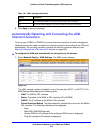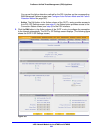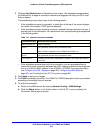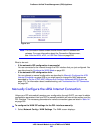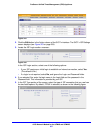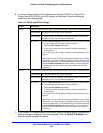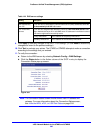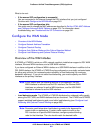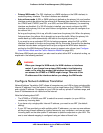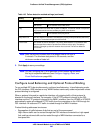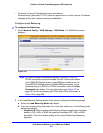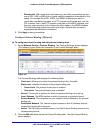
xDSL Network Module for the UTM9S and UTM25S
561
ProSecure Unified Threat Management (UTM) Appliance
What to do next:
• If the manual ISP configuration is successful:
You are connected to the Internet through the DSL interface that you just configured.
Continue with Configure the WAN Mode on page 561.
• If the manual ISP configuration fails:
You might need to change the MAC address as described in Set the UTM’s MAC Address
and Configure Advanced WAN Options on page 574. For information about
troubleshooting, see Troubleshoot the ISP Connection on page 541.
Configure the WAN Mode
• Overview of the WAN Modes
• Configure Network Address Translation
• Configure Classical Routing
• Configure Auto-Rollover Mode and the Failure Detection Method
• Configure Load Balancing and Optional Protocol Binding
Overview of the WAN Modes
A UTM9S or UTM25S in which an xDSL network module is installed can support a DSL WAN
interface, Ethernet WAN interfaces, and a USB WAN interface.
If you have configured an Ethernet WAN interface or a USB WAN interface in addition to the
DSL WAN interface, the UTM9S or UTM25S can be configured on a mutually exclusive basis
for either auto-rollover (for increased system reliability) or load balancing (for maximum
bandwidth efficiency). If you do not select load balancing, you need to specify one WAN
interface as the primary interface.
Note: In this section and the following sections of this appendix, the DSL
WAN interface is referred to as the DSL interface, the Ethernet WAN
interfaces are referred to as the WAN interfaces, and the USB WAN
interface is referred to as the USB interface.
• Load balancing mode. The UTM9S or UTM25S distributes the outbound traffic equally
among the DSL, USB, and WAN interfaces that are functional. The UTM9S and UTM25S
support weighted load balancing and round-robin load balancing (see Configure Load
Balancing and Optional Protocol Binding on page 566).
Note: Scenarios could arise when load balancing needs to be bypassed for
certain traffic or applications. If certain traffic needs to travel on the
DSL interface or a specific WAN interface, configure protocol binding
rules for that interface. The rule should match the desired traffic.



